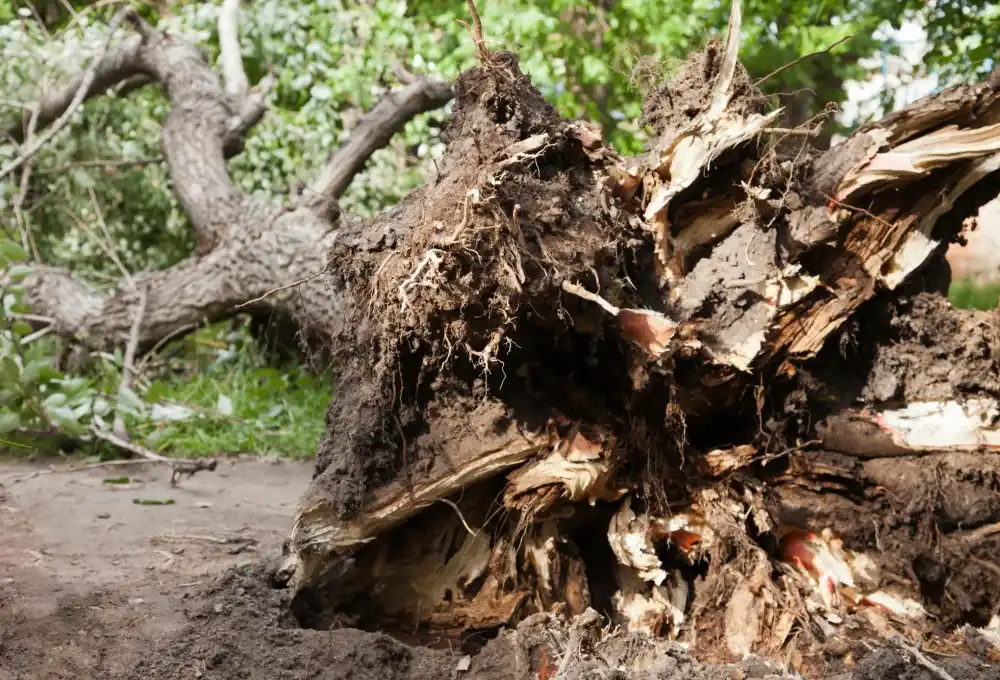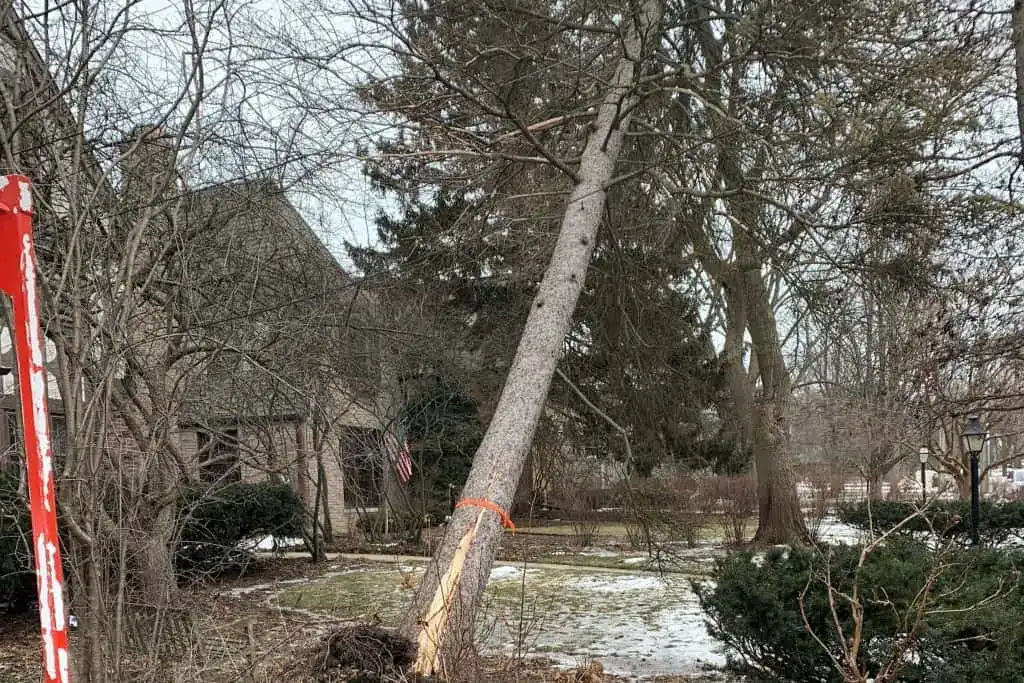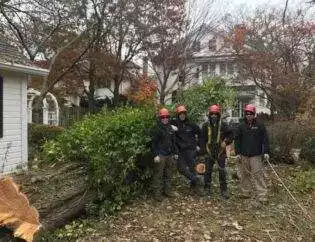
In the state of Illinois, the question of who is responsible for fallen tree removal can often be a source of confusion.
It is essential for residents to understand their rights and obligations when it comes to this matter. This article aims to provide guidance on the subject, ensuring that individuals can navigate the process effectively, from documenting everything to choosing a professional emergency tree removal company. By examining different scenarios and considering factors such as the cause of the tree's fall and its location, residents can determine the appropriate steps to take. Whether the fallen tree originated from a neighbor's property, public land, or even their own property, understanding the rules and regulations surrounding fallen tree removal is crucial. By doing so, residents can ensure prompt and proper action is taken for the safety and well-being of all involved.
The short answer is that it depends on a few factors: the local laws, whether it can be proved that the tree was neglected, whether there was damage to property, and the location of the tree itself.
We have included some general guidelines below, but keep in mind that the responsibility may vary in your case.

Neighbor's Tree Falls on Your Property
When a neighbor's tree falls on your property in Illinois, the responsibility for its removal falls on you, unless you can prove the tree was neglected (see the next section). This situation can be quite daunting, as it involves not only dealing with the physical damage caused by the fallen tree but also navigating the legal implications and potential costs associated with the incident.
One of the first steps to take after a neighbor's tree falls on your property is to contact your insurance company. They can guide you through the process of filing a claim and provide assistance in assessing the property damage costs. It is crucial to document the damage thoroughly by taking photographs and gathering any necessary evidence to support your claim.
Next, you should communicate with your neighbor about the situation. It is essential to maintain a respectful and open line of communication. Discuss the incident, the potential costs involved, and any insurance claims that need to be made. It is advisable to have these conversations in writing to ensure clarity and avoid any misunderstandings.
Regarding the tree removal process, it is advisable to hire a professional tree service and cleanup company to handle the task. They have the expertise and equipment necessary to safely remove the fallen tree without causing further damage to your property. Additionally, they can provide documentation of the tree removal process, which can be useful for insurance purposes.
Tree Falls Due to Neighbor's Negligence
When a tree falls on your property in Illinois due to your neighbor's negligence, such as their failure to address its rotting or dead condition, the responsibility for its removal falls on them. In such cases, the neighbor is liable for the tree removal and any resulting property damage. It is important to understand that negligence refers to the failure to exercise reasonable care, and if your neighbor had knowledge of the tree's hazardous condition but failed to take appropriate action, they can be held legally responsible.
If a tree falls on your property due to your neighbor's negligence, you may need to take immediate action to ensure the safety of your property and those around you. Start by documenting the incident, taking photographs of the fallen tree and any resulting damage. It is also advisable to inform your neighbor of the situation and request that they take responsibility for the tree removal and any necessary repairs.
In some cases, your neighbor's homeowner's insurance may cover the cost of tree removal and property damage. You may need to file an insurance claim and provide evidence of your neighbor's negligence. It is recommended to consult with your own insurance company to understand your coverage and determine the best course of action.
If your neighbor refuses to take responsibility for the fallen tree, you may need to seek legal recourse. Consult with an attorney who specializes in property law to understand your rights and options. They can guide you through the legal process and help you hold your neighbor accountable for their negligence. Keep in mind that you might have to prove the negligence in Court.
Tree Falls From Nearby Park or Public Land
If a tree falls on your property from a nearby park or other public land in Illinois, the responsibility for its removal falls on the community officials. It is the duty of the municipal government to ensure the safety and maintenance of public spaces, including trees on public land. In such cases, the community officials are responsible for organizing the removal of the fallen tree and any associated cleanup.
When a tree falls from a nearby park or public land onto your property, it is important to report the incident to the appropriate authorities as soon as possible. They will assess the situation and take necessary action to remove the tree and mitigate any hazards. However, it is worth noting that you may be held responsible for any property damage caused by the fallen tree. It is advisable to document the damage and contact your insurance company to discuss coverage options.
Tree removal fees in these instances are typically the responsibility of the municipality. However, if the fallen tree has caused damage to your property, you may need to seek compensation or reimbursement for the costs incurred. This can be done through insurance claims or by discussing the matter with the relevant community officials.
Public liability for tree falls from nearby parks or public land lies with the municipal government. They have a duty to maintain and manage public spaces in a safe manner, including regular tree inspections and removal of hazardous trees. It is their responsibility to ensure that trees on public land do not pose a risk to nearby properties.
Tree Falls on Public Road or Sidewalk
The responsibility for the removal of a tree that falls form your property on a public road or sidewalk in Illinois lies with the city.
Same as mentioned before, you might be responsible for removal costs if it can be proven the you knowingly failed to maintain the tree.
When a tree falls on a public road or sidewalk, it can pose a safety hazard to pedestrians and vehicles, obstructing the normal flow of traffic. Therefore, it is crucial for the city to promptly remove fallen trees to ensure public safety and minimize any inconvenience caused.
The tree removal process on public roads or sidewalks generally involves several steps. First, the city will assess the situation and determine the appropriate course of action. They will consider factors such as the size of the tree, the extent of the damage caused, and the urgency of removal. Once a plan is in place, trained professionals will be dispatched to remove the fallen tree safely and efficiently.
Tree removal safety is of utmost importance during this process. The city will ensure that proper safety measures are implemented to protect both the workers and the public. This may include the use of personal protective equipment, traffic control measures, and adherence to established safety protocols.
To carry out the tree removal process effectively, the city may employ specialized tree removal equipment. This can include cranes, chainsaws, wood chippers, and other tools necessary to safely remove the fallen tree from the public road or sidewalk.
It is important to note that tree removal regulations may vary among different cities in Illinois. However, most municipalities have guidelines and procedures in place to address the removal of fallen trees on public property. These regulations aim to ensure that the removal is carried out in a timely and efficient manner while prioritizing public safety.
In terms of tree removal cost, it generally falls upon the city to bear the expenses associated with removing trees on public roads or sidewalks. However, it is advisable to check with the local municipality for specific details regarding any potential costs or reimbursements.
Tree Falls on Your Property With No Damage
Responsibility for the removal of a fallen tree on your property in Illinois without any damage lies with the property owner. While it may seem like a simple task, there are several factors to consider when deciding how to handle the situation. One option is to attempt DIY tree removal, but it is important to weigh the potential risks and costs associated with this approach.
Firstly, it is crucial to consider the tree removal cost. DIY tree removal may seem like a cost-effective choice, but it can quickly become expensive if you lack the necessary tools and equipment. Additionally, without proper training and experience, you may inadvertently cause damage to your property or injure yourself or others.
Hiring professional arborists is another option to consider. These experts have the knowledge, skills, and specialized equipment to safely and efficiently remove the fallen tree. While this may involve additional costs, it ensures that the job is done properly and reduces the risk of accidents or further damage.
It is also important to be aware of any tree removal permits that may be required. The rule of thumb is that fallen trees usually do not require a removal permit, but you should still check both with your arborist and local authorities to see whether additional documentation is required.
Lastly, it is essential to prioritize safety precautions during the tree removal process. This includes wearing appropriate protective gear, such as gloves and goggles, and following proper techniques to prevent accidents.
Insurance Coverage for Fallen Tree Damages
Insurance coverage for fallen tree damages in Illinois is an important aspect to consider when addressing liability and potential financial burdens. Homeowner's insurance typically covers damage caused by fallen trees, including the cost of tree removal. However, it is essential to review your policy to determine the specific coverage and any limitations.
When a tree falls on your property, it is crucial to assess the extent of the damage and contact your insurance company promptly. They will guide you through the claims process and provide information on coverage for tree removal cost and any associated repairs. It is recommended to document the incident with photographs and keep records of any expenses incurred. This will insure you can prove the extent of the damage even after the storm damaged tree is cleaned up.
To minimize the risk of fallen trees, regular tree inspection and maintenance are essential. Hiring professional tree care services, such as certified arborists, can help identify potential hazards and provide appropriate tree trimming or removal if necessary. Additionally, tree pest control and disease management can help prevent weakened trees that are more susceptible to falling.
While homeowner's insurance typically covers damage caused by fallen trees, it is important to note that coverage may vary depending on the circumstances. For example, if a tree falls on your property due to a storm, it is usually covered. However, if the tree falls due to neglect or lack of maintenance, coverage may be denied.
Submitting a Claim to Your Insurance Company
To ensure a smooth claims process, promptly contact your insurance company after a fallen tree incident in Illinois. Submitting a claim to your insurance company is an important step in getting the necessary coverage for any damages caused by the fallen tree. Here are three key things to keep in mind during the insurance claim process:
- Understand your coverage limits: Review your insurance policy to understand the extent of coverage for fallen tree damages. Different policies may have varying limits, so it's important to be aware of what your policy specifically covers.
- Know your deductible requirements: Your insurance policy may have a deductible, which is the amount you are responsible for paying before your insurance coverage kicks in. Make sure you understand the deductible requirements and have the necessary funds available if you need to pay it.
- Gather documentation needed: When filing an insurance claim, it's crucial to provide the necessary documentation to support your claim. This may include photographs of the fallen tree and any resulting damages, as well as any repair estimates or invoices. Keep a record of any communication with your insurance company throughout the claims process.
Additionally, be aware that the time frame for claim resolution can vary depending on factors such as the complexity of the claim and the insurance company's workload. It's recommended to stay in regular contact with your insurance company to stay updated on the progress of your claim and to provide any additional information they may require. By following these steps and staying proactive throughout the insurance claim process, you can increase the likelihood of a timely and satisfactory resolution.
Responsibility for Fallen Tree Damages to Your Property
The responsibility for fallen tree damages to your property in Illinois depends on the circumstances surrounding the tree's fall. When a tree falls on your property, it is important to determine who is liable for the damages and who is responsible for the removal.
If the tree falls from your neighbor's property and causes damage to your property, the general rule is that your neighbor is not liable for the damages or the removal. However, there are exceptions to this rule. If the tree was in poor health or was visibly dead or rotting, and your neighbor failed to take appropriate action to remove it, they may be held responsible for the damages and removal costs. In such cases, it is important to gather evidence, such as photographs or expert opinions, to support your claim.
In terms of insurance coverage, if a tree falls on your property and causes damage, you should submit a claim to your insurance company. Most homeowners' insurance policies cover property damage from fallen trees, but it is always best to review your policy and consult with your insurance agent to understand the specific coverage and any deductibles that may apply.
If a tree falls on your property and there is no damage, it is generally your responsibility to arrange for its removal. However, if the tree fell from a nearby park or public land, the responsibility for removal may fall on community officials. On the other hand, if a tree falls on a public road or sidewalk, the city is responsible for its removal.
City's Responsibility for Tree Removal on Public Land
When it comes to the removal of fallen parkway trees on public land, the responsibility falls on the city. Community officials are tasked with ensuring the safety and maintenance of public spaces, including the removal of fallen trees. Here are three key points to consider regarding the city's responsibility for tree removal on public land:
- Safety of the Community: The city's responsibility for fallen tree removal on public land is primarily driven by the need to prioritize the safety of the community. Fallen trees can pose significant risks, especially when they obstruct roads, sidewalks, or other public areas. By promptly removing these trees, the city aims to prevent accidents and injuries, ensuring the well-being of its residents.
- Preservation of Public Property: Public land belongs to the community and is meant to be enjoyed by all. Fallen trees can cause damage to public property, such as parks, playgrounds, or recreational areas. By taking responsibility for tree removal, the city ensures that these public spaces remain accessible and well-maintained, promoting a sense of belonging and pride within the community.
- Shared Financial Burden: While the city assumes responsibility for fallen tree removal on public land, it is important to note that damages to private property caused by a fallen tree are the responsibility of the property owner. This shared financial burden ensures fairness and accountability within the community, as individuals are responsible for protecting their own properties while the city takes care of public spaces.

You must be logged in to post a comment.